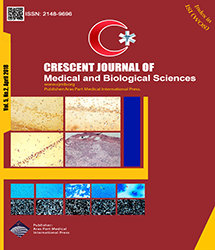
| Original Article | |
| The Correlation Between Umbilical Cord Blood Gases and Newborn Asphyxia | |
| Robabeh Taheripanah1, Marzieh Zamaniyan2,3, Maryam Ghafori4, Anahita Taheripanah5, Narges Malih6 | |
| 1Infertility and Reproductive Health Research Center, Shahid Beheshti University of Medical Sciences, Tehran, Iran 2Infertility Center, Department of Obstetrics and Gynecology, Mazandaran University of Medical Sciences, Sari, Iran 3Diabetes Research Center, Mazandaran University of Medical Sciences, Sari, Iran 4Educational developmental Center, Ministry of Health and Medical Education, Tehran, Iran 5Department of Molecular and Cellular Sciences, Faculty of Advanced Sciences and Technology Pharmaceutical Sciences Branch, Islamic Azad University, Tehran, Iran 6Social Determinants of Health Research Center, Shahid Beheshti University of Medical Sciences, Tehran, Iran |
|
|
CJMB 2018; 5: 123-127 Viewed : 4943 times Downloaded : 11006 times. Keywords : Fetal blood, Umbilical cord blood, Infant, Asphyxia, Prenatal diagnosis |
|
| Full Text(PDF) | Related Articles | |
| Abstract | |
Objectives: The aim of this study was to investigate the relationship between umbilical cord blood gases and neonatal asphyxia as valuable criteria for fetal distress and labor compilations. Materials and Methods: In this cross-sectional descriptive study of 150 deliveries (101 vaginal and 49 caesarean sections), singleton live-born infants between 34 and 42 weeks of gestation with no major anomalies. They were enrolled from November 2015 to March 2016, in delivery unit of obstetrics and gynecology ward, Imam Hossein Medical Center, Tehran, Iran. Blood samples were taken from umbilical vessels (arterial and venous) following delivery. All infants were monitored for Apgar scores at 1 and 5 minutes. Results: There were significant differences regarding venous blood lactate (P < 0.000) and pH (P < 0.000), venous (P = 0.002) and arterial (P = 0.038) blood base excess and venous (P < 0.000) and arterial (P = 0.002) blood PCO2 in samples from fetus with intrapartum distress compared to normal fetus. The mean Apgar score at 1 minute (P < 0.000) and 5 (P < 0.000) minutes were also significantly lower in the case group compared to the control group. Conclusions: The results of the present study indicate that lactate analysis, as well as umbilical cord blood analysis, might be useful predictors of fetal asphyxia at delivery. Their potential role as a predictor of prenatal outcome should be evaluated further in future studies. |
Cite By, Google Scholar
Google Scholar
PubMed
Online Submission System
 CJMB ENDNOTE ® Style
CJMB ENDNOTE ® Style
 Tutorials
Tutorials
 Publication Charge
Medical and Biological Research Center
About Journal
Publication Charge
Medical and Biological Research Center
About Journal
Aras Part Medical International Press Editor-in-Chief
Arash Khaki
Deputy Editor
Zafer Akan


















